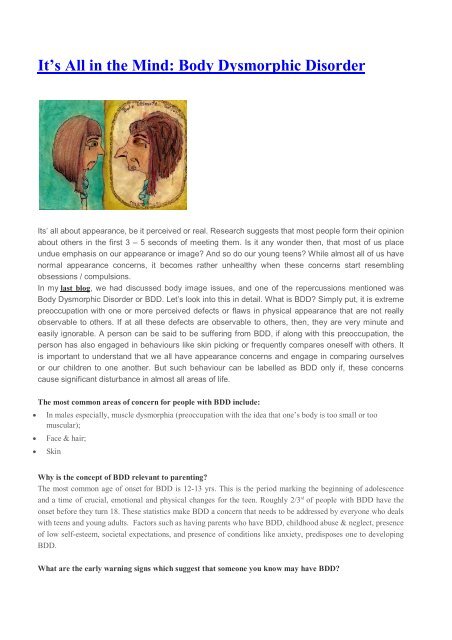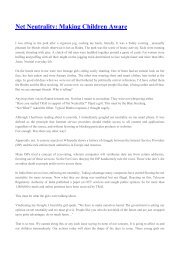It’s All in the Mind: Body Dysmorphic Disorder
Its’ all about appearance, be it perceived or real. Research suggests that most people form their opinion about others in the first 3 – 5 seconds of meeting them. Is it any wonder then, that most of us place undue emphasis on our appearance or image? And so do our young teens? While almost all of us have normal appearance concerns, it becomes rather unhealthy when these concerns start resembling obsessions / compulsions. In my last blog, we had discussed body image issues, and one of the repercussions mentioned was Body Dysmorphic Disorder or BDD. Let’s look into this in detail. What is BDD? Simply put, it is extreme preoccupation with one or more perceived defects or flaws in physical appearance that are not really observable to others. If at all these defects are observable to others, then, they are very minute and easily ignorable. A person can be said to be suffering from BDD, if along with this preoccupation, the person has also engaged in behaviours like skin picking or frequently compares oneself with others. It is important to understand that we all have appearance concerns and engage in comparing ourselves or our children to one another. But such behaviour can be labelled as BDD only if, these concerns cause significant disturbance in almost all areas of life.
Its’ all about appearance, be it perceived or real. Research suggests that most people form their opinion about others in the first 3 – 5 seconds of meeting them. Is it any wonder then, that most of us place undue emphasis on our appearance or image? And so do our young teens? While almost all of us have normal appearance concerns, it becomes rather unhealthy when these concerns start resembling obsessions / compulsions.
In my last blog, we had discussed body image issues, and one of the repercussions mentioned was Body Dysmorphic Disorder or BDD. Let’s look into this in detail. What is BDD? Simply put, it is extreme preoccupation with one or more perceived defects or flaws in physical appearance that are not really observable to others. If at all these defects are observable to others, then, they are very minute and easily ignorable. A person can be said to be suffering from BDD, if along with this preoccupation, the person has also engaged in behaviours like skin picking or frequently compares oneself with others. It is important to understand that we all have appearance concerns and engage in comparing ourselves or our children to one another. But such behaviour can be labelled as BDD only if, these concerns cause significant disturbance in almost all areas of life.
You also want an ePaper? Increase the reach of your titles
YUMPU automatically turns print PDFs into web optimized ePapers that Google loves.
<strong>It’s</strong> <strong>All</strong> <strong>in</strong> <strong>the</strong> M<strong>in</strong>d: <strong>Body</strong> <strong>Dysmorphic</strong> <strong>Disorder</strong><br />
Its’ all about appearance, be it perceived or real. Research suggests that most people form <strong>the</strong>ir op<strong>in</strong>ion<br />
about o<strong>the</strong>rs <strong>in</strong> <strong>the</strong> first 3 – 5 seconds of meet<strong>in</strong>g <strong>the</strong>m. Is it any wonder <strong>the</strong>n, that most of us place<br />
undue emphasis on our appearance or image? And so do our young teens? While almost all of us have<br />
normal appearance concerns, it becomes ra<strong>the</strong>r unhealthy when <strong>the</strong>se concerns start resembl<strong>in</strong>g<br />
obsessions / compulsions.<br />
In my last blog, we had discussed body image issues, and one of <strong>the</strong> repercussions mentioned was<br />
<strong>Body</strong> <strong>Dysmorphic</strong> <strong>Disorder</strong> or BDD. Let’s look <strong>in</strong>to this <strong>in</strong> detail. What is BDD? Simply put, it is extreme<br />
preoccupation with one or more perceived defects or flaws <strong>in</strong> physical appearance that are not really<br />
observable to o<strong>the</strong>rs. If at all <strong>the</strong>se defects are observable to o<strong>the</strong>rs, <strong>the</strong>n, <strong>the</strong>y are very m<strong>in</strong>ute and<br />
easily ignorable. A person can be said to be suffer<strong>in</strong>g from BDD, if along with this preoccupation, <strong>the</strong><br />
person has also engaged <strong>in</strong> behaviours like sk<strong>in</strong> pick<strong>in</strong>g or frequently compares oneself with o<strong>the</strong>rs. It<br />
is important to understand that we all have appearance concerns and engage <strong>in</strong> compar<strong>in</strong>g ourselves<br />
or our children to one ano<strong>the</strong>r. But such behaviour can be labelled as BDD only if, <strong>the</strong>se concerns<br />
cause significant disturbance <strong>in</strong> almost all areas of life.<br />
<br />
<br />
<br />
The most common areas of concern for people with BDD <strong>in</strong>clude:<br />
In males especially, muscle dysmorphia (preoccupation with <strong>the</strong> idea that one’s body is too small or too<br />
muscular);<br />
Face & hair;<br />
Sk<strong>in</strong><br />
Why is <strong>the</strong> concept of BDD relevant to parent<strong>in</strong>g?<br />
The most common age of onset for BDD is 12-13 yrs. This is <strong>the</strong> period mark<strong>in</strong>g <strong>the</strong> beg<strong>in</strong>n<strong>in</strong>g of adolescence<br />
and a time of crucial, emotional and physical changes for <strong>the</strong> teen. Roughly 2/3 rd of people with BDD have <strong>the</strong><br />
onset before <strong>the</strong>y turn 18. These statistics make BDD a concern that needs to be addressed by everyone who deals<br />
with teens and young adults. Factors such as hav<strong>in</strong>g parents who have BDD, childhood abuse & neglect, presence<br />
of low self-esteem, societal expectations, and presence of conditions like anxiety, predisposes one to develop<strong>in</strong>g<br />
BDD.<br />
What are <strong>the</strong> early warn<strong>in</strong>g signs which suggest that someone you know may have BDD?
As already mentioned, a preoccupation with <strong>the</strong> physical appearance;<br />
Frequent exam<strong>in</strong>ation <strong>in</strong> <strong>the</strong> mirror or avoidance of it altoge<strong>the</strong>r;<br />
Feel<strong>in</strong>g of ugl<strong>in</strong>ess and often talk<strong>in</strong>g about it;<br />
A need to stay housebound and avoid social situations;<br />
Frequently seek<strong>in</strong>g assurance from o<strong>the</strong>rs regard<strong>in</strong>g any specific feature or whole of one’s appearance;<br />
Excessive groom<strong>in</strong>g, for e.g., sk<strong>in</strong> pick<strong>in</strong>g to <strong>the</strong> extent that it can cause severe sk<strong>in</strong> damage;<br />
What can you do if your teen shows <strong>the</strong> BDD symptoms?<br />
Read up about what is BDD and how you can approach <strong>the</strong> subject with <strong>the</strong> concerned person;<br />
Be open to your teen’s views about body image and discuss as to why <strong>the</strong>y hold <strong>the</strong>se views (if unhealthy);<br />
Talk frequently about <strong>the</strong> importance of be<strong>in</strong>g content with oneself. Model be<strong>in</strong>g happy with your body, <strong>in</strong><br />
front of your teen if needed, as this will help <strong>the</strong>m.<br />
Seek professional help. The professionals that you will need to see <strong>in</strong> a suspected case of BDD <strong>in</strong>clude: (a) your<br />
physician – who can conduct any physical exam<strong>in</strong>ations to ascerta<strong>in</strong> <strong>the</strong> presence/absence and extent of <strong>the</strong><br />
perceived defect; & (b) psychologist / mental health provider- who can talk about <strong>the</strong> feel<strong>in</strong>gs, thoughts,<br />
behaviour patterns, and help with chang<strong>in</strong>g <strong>the</strong> unfounded beliefs or actions.<br />
It is important to remember that BDD goes hand <strong>in</strong> hand with suicide risk, and this risk is high <strong>in</strong> adolescence.<br />
You need to f<strong>in</strong>d out if your teen is hav<strong>in</strong>g suicidal ideation and seek professional help on an urgent basis if<br />
needed.<br />
<strong>Body</strong> dysmorphic disorder, may not seem to appear as life threaten<strong>in</strong>g as several o<strong>the</strong>r mental conditions. This is<br />
not true, however, because an adolescent / adult suffer<strong>in</strong>g from BDD is often at <strong>the</strong> risk of poor everyday<br />
function<strong>in</strong>g, <strong>in</strong>clud<strong>in</strong>g a high risk of hospitalisation, much like <strong>in</strong> <strong>the</strong> case of o<strong>the</strong>r mental conditions. For<br />
<strong>in</strong>stance, a normal look<strong>in</strong>g teen hav<strong>in</strong>g BDD, may suddenly start com<strong>in</strong>g up with reasons not to go to school,<br />
when <strong>the</strong> real reason is that she / he feels “ugly”. 20% of youth with BDD report dropp<strong>in</strong>g out of school ma<strong>in</strong>ly<br />
because of <strong>the</strong>ir BDD symptoms.<br />
Help for BDD is easily available <strong>in</strong> <strong>the</strong> form of psycho<strong>the</strong>rapy, medications and if needed, <strong>in</strong>-patient care. <strong>Body</strong><br />
dysmorphic symptoms have <strong>the</strong> power to consume one’s life. Given its early age of onset, it’s important that we,<br />
and all who deal with young m<strong>in</strong>ds, keep a track of any warn<strong>in</strong>g sign and provide help at <strong>the</strong> earliest. Also see<br />
more <strong>in</strong>fo @ http://www.parentedge.<strong>in</strong><br />
Sources:<br />
1. DSM 5<br />
2. Mayocl<strong>in</strong>ic.org

















